Routes of Santiago de Compostela in Spain: The Route of Santiago de Compostela is also known as the Way of St. James. For more than a thousand years, pilgrims have walked the Route of Santiago de Compostela, their final destination is the Cathedral of Santiago de Compostela with the tomb of the apostle St. James. The Cathedral of Santiago de Compostela in Spain is one of the most important Christian pilgrimage sites, the other two are Jerusalem and Rome. There are more than 1800 associated monumental buildings along the Route of Santiago de Compostela, such as bridges, bell towers, cathedrals, churches, city gates, hospitals, inns and monasteries, like the San Millán Yuso and Suso Monasteries. The three most important cathedrals along the Route of Santiago the Compostela in Spain are the Burgos Cathedral, the Leon Cathedral and the Cathedral of Santiago the Compostela. León Cathedral was closely modeled on the Gothic cathedrals of France, especially the Reims Cathedral. The Camino Primitivo is the oldest part of the pilgrimage route to Santiago de Compostela, the route starts at the Cathedral of Oviedo in Asturias. The Route of Santiago de Compostela in Spain was declared a UNESCO World Heritage Site in 1993. In 2015, the heritage site was extended to include some of the earliest pilgrimage routes to Santiago de Compostela in Spain. The UNESCO World Heritage is now inscribed on the UNESCO World Heritage List as: Routes of Santiago de Compostela: Camino Francés and Routes of Northern Spain.
www.werelderfgoedfotos.nl © Copyright World Heritage Photos Classic Car Road Trip
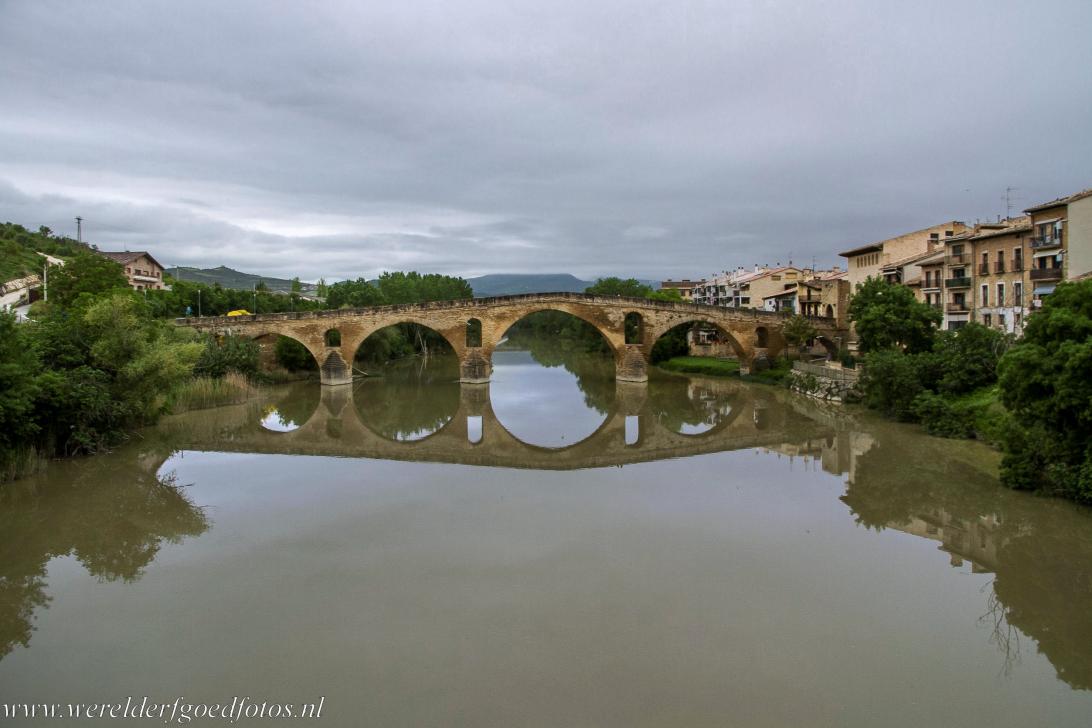
Route of Santiago de Compostela in Spain: The Romanesque stone bridge of Puente la Reina was built in the 11th century to help pilgrims cross the Arga River. The major pilgrimage routes from France come together at Puente la Reina. From Puente la Reina, the route continues in several routes to Santiago de Compostela. The small town of Puente la Reina was, and still is, strongly influenced by the pilgrimage route to Santiago de Compostela.

Route of Santiago de Compostela in Spain: The Romanesque stone bridge of Puente la Reina was built in the 11th century to help pilgrims cross the Arga River. The major pilgrimage routes from France come together at Puente la Reina. From Puente la Reina, the route continues in several routes to Santiago de Compostela. The small town of Puente la Reina was, and still is, strongly influenced by the pilgrimage route to Santiago de Compostela.
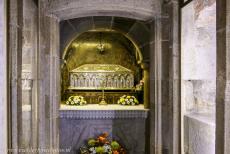
Route of Santiago de Compostela in Spain: The Cathedral of Santiago de Compostela, the silver box containing the remains of the apostle James. For more than 1000 years, pilgrims have been walking along the Route of Santiago de Compostela, their final destination is the Cathedral of Santiago de Compostela with the tomb of the apostle James. In the course of time, the remains of the apostle had been almost forgotten, they were rediscovered in the 19th century.
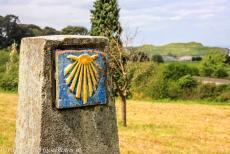
The scallop shell is the iconic symbol of the Route of Santiago de Compostela. The route across Spain stretches from the Pyrenees to Cape Finisterre, a cliff on the Atlantic Coast. The Route of Santiago de Compostela was already mentioned in the Codex Calixtinus, this 12th century illuminated manuscript is regarded the first travel guide book for pilgrims walking to Santiago de Compostela. The Route of Santiago de Compostela in Spain is a UNESCO World Heritage.

Route of Santiago de Compostela in Spain: The Lugo Cathedral viewed from the Roman Walls of Lugo. The Roman Walls of Lugo are also an UNESCO World Heritage. The cathedral was built in the Romanesque style the 12th century, the cathedral has also Gothic, Renaissance, Baroque and Neoclassical elements. The Lugo Cathedral is situated along the Camino de Santiago, the Route of Santiago de Compostela, also known as the Way of St. James.

Route of Santiago de Compostela in Spain: León Cathedral is one of the three most important cathedrals along the route of Santiago de Compostela in Spain, the other are Burgos Cathedral and the Cathedral of Santiago de Compostela. León Cathedral is widely known for its medieval stained-glass windows, the construction of the Gothic León Cathedral started in 1205, León Cathedral was closely modeled on the Gothic cathedrals of France, especially Reims Cathedral.
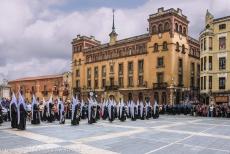
Route of Santiago de Compostela in Spain: Easter Holy Week Procession in front of the León Cathedral, Santa María de Regla de León, in the baskground the Diocesan Cathedral Museum. The León Cathedral and the Diocesan Cathedral Museum are situated on the Plaza Regla in the historic centre of León. Spain is famous for the Easter processions during Semana Santa, the Holy Week. The Spanish Town of León is situated along the Route of Santiago de Compostela.

The Route of Santiago de Compostela in Spain nearby the Monastery of San Millán Suso. There are more than 1800 monumental buildings along the Route of Santiago de Compostela, such as cathedrals, churches, chapels, monasteries, bridges, hospitals, hostels and inns, in 166 villages and towns, among them San Millán Yuso and Suso, two Monasteries situated in the small village of San Millán de la Cogolla, about 88 km east of Burgos in Spain.
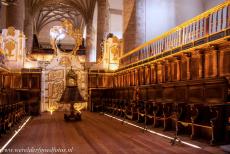
Route of Santiago de Compostela in Spain: The church of the Monastery of San Millán Yuso. During the fall and spring equinox, the sun shines through a rose window and then through the circle above this golden doorway to make a perfect circle of sunlight on the church floor of San Millán Yuso. The doorway creates a separation between the two parts of the church. The church was built between 1504 and 1540.
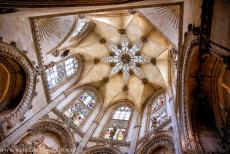
Route of Santiago de Compostela in Spain: The dome of the Chapel of the Condestable in the Burgos Cathedral. Pilgrims usually enter the cathedral through the 'Puerta de la Coronería', the Coronation Portal. Burgos Cathedral was a major stop for pilgrims on their way to Santiago de Compostela. The importance of Burgos as a major pilgrimage destination is reflected in the fact that it once had thirty hostels, only for pilgrims.
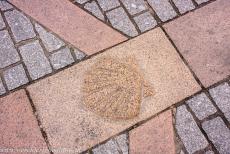
Route of Santiago de Compostela in Spain: A symbol of the Camino de Santiago, the Way of St. James, near Burgos Cathedral. Medieval pilgrims often wore a scallop shell on their hat or on their clothes. Nowadays, the symbol of the scallop shell is seen on signposts, tiles and buildings along the route in order to guide pilgrims on their journey to Santiago de Compostela in Spain. The Route of Santiago de Compostela in Spain became a UNESCO World Heritage in 1993.

Route of Santiago de Compostela in Spain: A bronze statue depicting a very exhausted pilgrim outside Burgos Cathedral. Burgos is situated on one of the oldest and most important stretches of the Route of Santiago de Compostela, the Camino Francés, the French Way. The French town of St. Jean Pied de Port is the official starting point of the Camino Francés. The Route of Santiago de Compostela in Spain was inscribed on the UNESCO World Heritage List in 1993.

Route of Santiago de Compostela in Spain: In our owm classic Mini, we drove along several sections of the Route of Santiago de Compostela. One of the monumental buildings along the pilgrimage route is the San Miguel de Lillo, an Asturian pre-Romanesque church near Oviedo. The Spanish town of Oviedo is the starting point of the Camino Primitivo, the Original Way, the first route to Santiago de Compostela, followed by King Alfonso II of Asturias in the 9th century.

Route of Santiago de Compostela: The lighthouse at the top of Cape Finisterre, situated on the Atlantic Coast, about 90 km from Santiago de Compostela. Cape Finisterre, meaning the End of the World, is the final destination for many pilgrims on the Route of Santiago the Compostela, the pilgrimage to the shrine of the apostle James. Nowadays, it is a tradition for some pilgrims to burn their clothes or walking shoes at the end of their journey at Cape Finisterre.
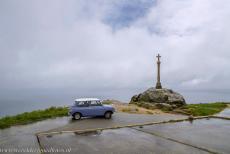
Route de Santiago de Compostela in Spain: Our own classic Mini, a 1974 Mini Authi, in front of the stone cross at Cape Finisterre. Every year, over 100,000 walkers, cyclists and car drivers make their way to Cape Finisterre, a rocky peninsula situated on the west coast of Spain. The Camino de Finisterre is an unique route from Santiago de Compostela to Cape Finisterre and the last section of the Route of Santiago de Compostela.

Route de Santiago de Compostela in Spain: The zero kilometre signpost of the Route of Santiago de Compostela is situated at Cape Finisterre in Spain. For many pilgrims, Cape Finisterre is the very end of their pilgrimage to Santiago de Compostela. Cape Finisterre and its surrounding headland is considered a mystical place since the earliest times and probably a place of worship to the sun for the Phoenicians and Celtic tribes.
